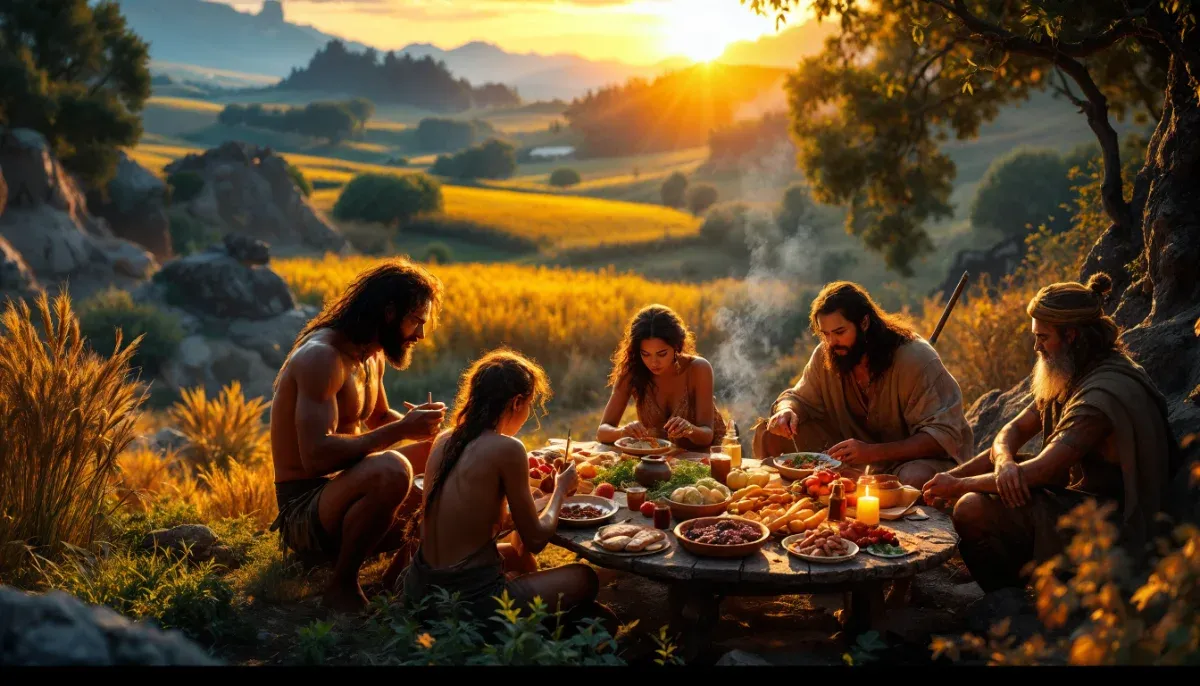Traditional Italian Cuisine and Its Health Impacts: A Hitchhiker’s Guide
Introduction Welcome, traveler, to the bewildering world of traditional Italian cuisine – a place where flavor

Human nutrition is a story as old as our species, marked by survival, adaptation, and transformation. From the first foragers on the African plains to modern consumers navigating dietary fads and functional foods, our relationship with what we eat has sculpted not just our bodies, but our civilizations. Let’s take a compelling journey through the ages to understand how our nutritional evolution has shaped who we are today.

Roughly 3.5 million years ago, early hominins like Australopithecus afarensis began transitioning from leafy forest diets to more varied savannah foods. Fossilized tooth enamel shows a surprising inclusion of tough C4 plants like grasses and sedges. This dietary pivot marked a key adaptation to shifting environments.
Around 1.9 million years ago, Homo erectus harnessed the power of fire. Cooking made tubers and meat easier to chew and digest, likely fueling our ancestors' brain growth. While fire helped neutralize toxins and improve calorie extraction, it also introduced new risks—like respiratory issues from smoke exposure.
Dental evidence even shows seasonal dietary shifts in species like Paranthropus, showcasing a level of flexibility crucial for survival.
By 2.5 million years ago, hominins were regularly eating meat, as proven by animal bones with butchery marks and stone tools. This shift likely supported the physical and energetic demands of migration and endurance activities.
The brain, demanding 20% of our resting energy, thrived on nutrient-dense foods like fatty meats and fish. This led to what scientists call the "expensive tissue hypothesis"—smaller guts in exchange for bigger brains. Over time, scavenging evolved into cooperative hunting, enhancing social bonds and communication.
Neanderthals favored large game in cold climates, while early Homo sapiens adapted to a wider variety of resources, possibly giving them a survival edge.
Fast forward to around 12,000 years ago. The rise of agriculture transformed nutrition. Grains like wheat, maize, and rice became dietary cornerstones, but this shift came with consequences. Early farmers often showed signs of malnutrition—shorter stature, more cavities, and iron deficiencies.
In places like Mesopotamia and East Asia, irrigation and communal labor shaped not only food production but also social hierarchies. Elites stockpiled grains while others faced scarcity.
The switch to carb-heavy diets also influenced genetic adaptations like lactase persistence in dairy-consuming cultures. Yet overreliance on single staples led to nutrient deficiencies, including pellagra and beriberi.
Fermentation practices, from Korean kimchi to European sauerkraut, emerged to boost nutrient absorption and preserve food across seasons.
With the Industrial Revolution, food systems went global. Mechanization, railroads, and factories brought canned goods and refined sugar to the masses. But urban life led to deficiencies—rickets from lack of sunlight and poor diets spurred food fortification in the early 20th century.
Wars accelerated scientific breakthroughs. Discoveries of vitamins and minerals gave rise to public health campaigns and fortified products like iodized salt and enriched flour.
Modern nutrition science blossomed, identifying macronutrients and guiding meal planning in schools and homes. However, a mid-century push for low-fat diets backfired, leading to an overconsumption of sugar and rising obesity rates.
Today’s food culture is a melting pot. Globalization has made processed foods ubiquitous, displacing traditional diets and contributing to a surge in obesity, even as undernutrition persists in many regions.
The environment is paying the price too—industrial farming depletes soils and pollutes water. The rise of regenerative agriculture and sustainable practices is now essential for long-term food security.
Personalized nutrition is gaining traction, thanks to advances in genetics and gut microbiome research. Foods are now being tailored to individual needs, while functional items like probiotic yogurt and omega-3-enriched eggs blur the line between medicine and meals.
Cultural dietary laws—from kosher to vegetarianism—encode thousands of years of ecological and spiritual adaptation. Even religious fasting rituals may offer metabolic benefits, aligning with today’s intermittent fasting trends.
But ultra-processed foods are exploiting our ancient cravings for sweet and salty, creating a discord between modern consumption and our evolutionary wiring.
Nutrition is both a product and a driver of human history. Every dietary leap—from fire to food science—has brought both progress and pitfalls. Today, as we face the dual challenges of chronic disease and environmental collapse, the lessons of our nutritional journey have never been more relevant.
We must diversify our diets, revive traditional food wisdom, and align our eating habits with both our biological needs and planetary limits. Because in understanding how we’ve eaten, we unlock a powerful path to how we can thrive.
[1] https://www.bbc.com/news/science-environment-22752937
[2] https://factsanddetails.com/world/cat56/sub360/entry-8902.html
[3] https://www.universiteitleiden.nl/en/liveable-planet/case-studies/fires-food-and-the-evolution-of-human-detoxification-capabilities
[4] https://pmc.ncbi.nlm.nih.gov/articles/PMC6083251/
[5] https://time.com/4017785/diets-early-humans-eating-habits/
[6] https://pmc.ncbi.nlm.nih.gov/articles/PMC4272645/
[7] https://phys.org/news/2016-04-neandertals-upper-paleolithic-homo-sapiens.html
[8] https://kids.frontiersin.org/articles/10.3389/frym.2020.555342
[9] https://www.frontiersin.org/journals/sustainable-food-systems/articles/10.3389/fsufs.2020.00041/full
[10] https://hamptonsbrine.com/blogs/blog/the-role-of-fermentation-in-preserving-food-a-history-of-fermentation-as-a-method-of-food-preservation-and-how-raw-sauerkraut-and-its-probiotic-brine-fit-into-this-tradition
[11] https://www.alimentarium.org/en/story/industrialisation-food-creates-unease
[12] https://pmc.ncbi.nlm.nih.gov/articles/PMC1440852/
[13] https://pmc.ncbi.nlm.nih.gov/articles/PMC11357412/
[14] https://www.americanscientist.org/article/gene-culture-coevolution-and-human-diet
[15] https://theconversation.com/our-ancient-primate-ancestors-had-an-appetite-for-soft-fruits-and-their-diet-shaped-human-evolution-220218
[16] https://pmc.ncbi.nlm.nih.gov/articles/PMC3235142/
[17] https://pmc.ncbi.nlm.nih.gov/articles/PMC4874400/
[18] https://www.acsedu.co.uk/uploads/Food/Lesson 1 and Assignment 1 Sample Human Nutrition II.pdf
[19] https://www.pnas.org/doi/10.1073/pnas.0903821106
[20] https://www.mpg.de/events/40079/9023196
[21] https://www.york.ac.uk/archaeology/about/news/2018/british-teeth-unlock-ancient-diet/
[22] https://pmc.ncbi.nlm.nih.gov/articles/PMC9460423/
[23] https://pmc.ncbi.nlm.nih.gov/articles/PMC17605/
[24] https://en.wikipedia.org/wiki/Homo_erectus
[25] https://www.supplysidesj.com/business-resources/basf-fire-s-effects-in-human-nutrition-likely-to-be-small
[26] https://www.npr.org/sections/thesalt/2016/10/25/497094756/dental-detectives-what-fossil-teeth-reveal-about-ancestral-human-diets
[27] https://www.timesofisrael.com/early-man-ate-carbs-and-processed-food-780000-years-ago-northern-israel-site-shows/
[28] https://www.pnas.org/doi/10.1073/pnas.2218096120
[29] https://pubmed.ncbi.nlm.nih.gov/31733113/
[30] https://ecohumanism.co.uk/joe/ecohumanism/article/view/4002
[31] https://www.israelhayom.com/2023/06/04/the-surprising-diet-of-early-humans-scholar-drills-into-thousands-of-years-of-dental-plaque/
[32] https://theconversation.com/how-the-diets-of-early-humans-explain-our-eating-habits-46481
[33] https://www.americanscientist.org/article/a-worms-view-of-human-evolution
[34] https://www.eufic.org/en/food-safety/article/the-why-how-and-consequences-of-cooking-our-food
[35] https://news.harvard.edu/gazette/story/2021/05/study-explains-early-humans-ate-starch-and-why-it-matters/
[36] https://www.ars.usda.gov/news-events/news/research-news/2001/scientific-sleuths-track-the-origin-of-tapeworms-in-humans/
[37] https://www.sciencedirect.com/science/article/abs/pii/S0950329317300642
[38] https://pmc.ncbi.nlm.nih.gov/articles/PMC4847867/
[39] https://pubmed.ncbi.nlm.nih.gov/25627083/
[40] https://nutritionmeetsfoodscience.com/2025/01/07/what-happens-when-we-cook-the-food/
[41] https://theconversation.com/neanderthals-how-a-carnivore-diet-may-have-led-to-their-demise-193764
[42] https://pmc.ncbi.nlm.nih.gov/articles/PMC4163920/
[43] https://www.news-medical.net/life-sciences/The-Biochemistry-of-Cooking.aspx
[44] https://www.sciencedirect.com/science/article/abs/pii/S0047248414000189
[45] https://rockedu.rockefeller.edu/component/biochemistry-fermented-foods/
[46] https://regions.regionalstudies.org/ezine/article/sustainable-agriculture/?print=pdf
[47] https://www.sciencedirect.com/science/article/abs/pii/S0308521X0600120X
[48] https://www.lhf.org/2014/03/beyond-sauerkraut-a-brief-history-of-fermented-foods/
[49] https://www.sciencedirect.com/science/article/abs/pii/S2211912420300389
[50] https://www.frontiersin.org/journals/sustainable-food-systems/articles/10.3389/fsufs.2023.1340035/full
[51] https://pmc.ncbi.nlm.nih.gov/articles/PMC8618017/
[52] https://www.farm-europe.eu/blog-en/ipcc-managing-agricultural-trade-offs-key-to-successful-climate-transition/
[53] https://spring-nutrition.org/sites/default/files/understanding_the_linkages_between_agriculture_and_health-ifpri_2006.pdf
[54] https://nchfp.uga.edu/resources/entry/historical-origins-of-food-preservation
[55] https://www.sciencedirect.com/science/article/pii/S0921800924002544
[56] https://knowledge4policy.ec.europa.eu/publication/adoption-impacts-agricultural-technologies-sustainable-natural-resource-management_en
[57] https://ecommons.cornell.edu/items/6575aaff-3c59-48ca-87d8-1cea259ec77d
[58] https://libguides.aisr.org/industrialrevolution/food
[59] https://pmc.ncbi.nlm.nih.gov/articles/PMC6132234/
[60] https://www.fao.org/3/cd2144en/online/state-of-agricultural-commodity-markets/2024/structural-transformation-nutrition-transition.html
[61] https://foodsystemprimer.org/production/industrialization-of-agriculture
[62] https://www.naturalhealers.com/blog/nutrition-history/
[63] https://seeds.ca/schoolfoodgardens/the-impact-of-globalization-on-the-food-system/
[64] https://www.worldhistory.org/article/2191/agriculture-in-the-british-industrial-revolution/
[65] https://www.nutritionsociety.org/blog/impact-nutrition-science-past-present-and-future-human-health
[66] https://www.ijfans.org/uploads/paper/4eb862da99179b03548a62cabd981e84.pdf
[67] https://www.regalrexnord.com/regal-rexnord-insights/industrial-revolution-impact-agriculture
[68] https://www.sciencedirect.com/science/article/pii/S0022316622156579
[69] https://www.sciencedirect.com/science/article/pii/S2161831324001145
[70] https://pmc.ncbi.nlm.nih.gov/articles/PMC10838982/
[71] https://www.nationalgeographic.com/foodfeatures/evolution-of-diet/
[72] https://www.alliedacademies.org/articles/exploring-the-impact-of-modern-diets-on-human-health-trends-challenges-and-solutions-30094.html
[73] https://xiahepublishing.com/2472-0712/ERHM-2017-00027
[74] https://www.arts.ubc.ca/news/the-intersection-of-culture-and-cuisine-how-food-shapes-our-identity/
[75] https://www.longdom.org/open-access/modern-diet-and-its-impact-on-human-health-35026.html
[76] https://www.mdpi.com/2072-6643/12/10/3118
[77] https://lifestyle.sustainability-directory.com/term/dietary-culture-evolution/
[78] https://pmc.ncbi.nlm.nih.gov/articles/PMC7071223/
[79] https://onlinelibrary.wiley.com/doi/full/10.1002%2Fmnfr.202200077
[80] https://www.emerald.com/insight/content/doi/10.1108/bfj-12-2021-1337/full/html
[81] https://www.emerald.com/insight/content/doi/10.1108/eb058806/full/html
[82] https://pubmed.ncbi.nlm.nih.gov/24612646/
[83] https://www.kit.nl/wp-content/uploads/2022/10/Working_Paper_Agri_Health.pdf
[84] https://assets.fsnforum.fao.org/public/discussions/contributions/Food Security paper - final - Converting trade-offs to trade-ons.pdf
[85] https://pmc.ncbi.nlm.nih.gov/articles/PMC7695682/
[86] https://libguides.lindahall.org/fermentation/history/LouisPasteur
[87] https://ecdpm.org/application/files/1116/5546/8584/Understanding-Managing-Trade-Offs-Food-Systems-Interventions-Case-Nakuru-County-Kenya-Discussion-Paper-293-ECDPM-February-2021.pdf
[88] https://pmc.ncbi.nlm.nih.gov/articles/PMC11466017/
[89] https://pubmed.ncbi.nlm.nih.gov/29899124/
[90] https://courses.lumenlearning.com/suny-hccc-worldhistory2/chapter/effects-of-the-agricultural-revolution/
[91] https://www.bmj.com/content/361/bmj.k2392
[92] https://pmc.ncbi.nlm.nih.gov/articles/PMC9294073/
[93] https://library.fiveable.me/international-food-culture/unit-3/industrial-revolution-impact-food-systems/study-guide/ArGn8FUaZIzHx2YK
[94] https://en.wikipedia.org/wiki/Nutritional_science
[95] https://www.ijirem.org/DOC/24-modern-food-habits-and-its-impact-on-human-health.pdf
[96] https://consensus.app/questions/potential-personalized-nutrition-based-genetic/
[97] https://health.economictimes.indiatimes.com/news/industry/modern-dietary-challenges-impact-on-adult-health-and-emerging-issues/112109670
[98] https://www.frontiersin.org/journals/nutrition/articles/10.3389/fnut.2024.1346144/full
[99] https://airgarden.com.au/blogs/news/why-the-modern-diet-could-be-worse-than-smoking